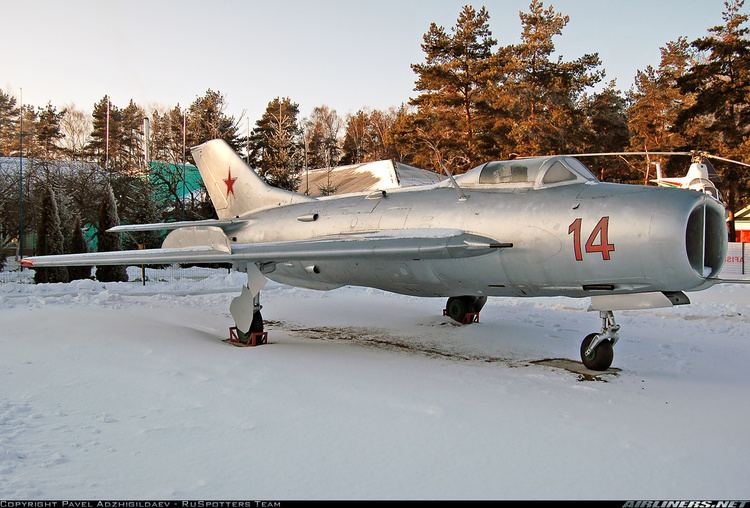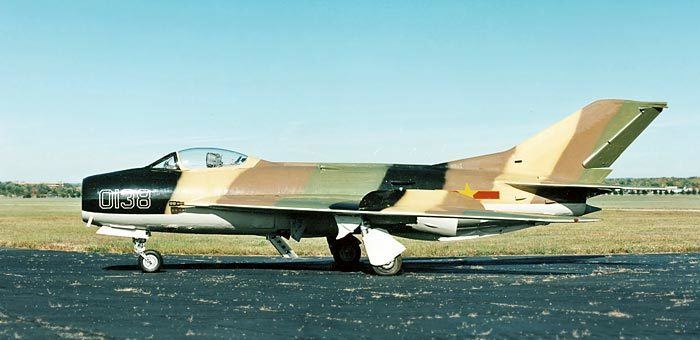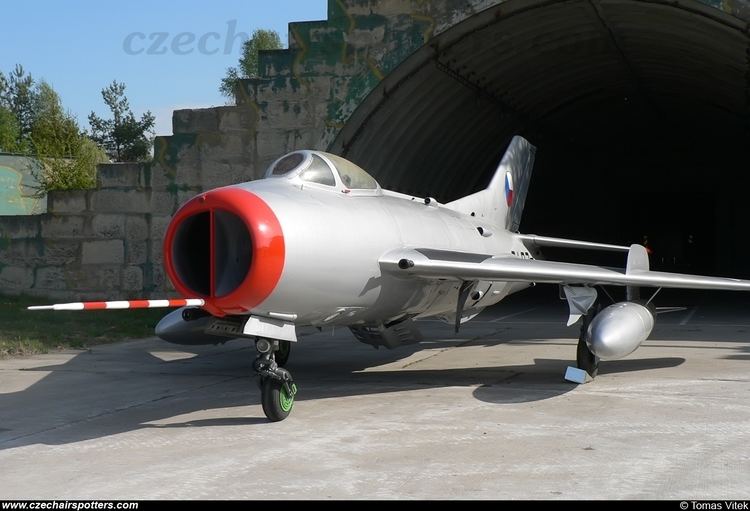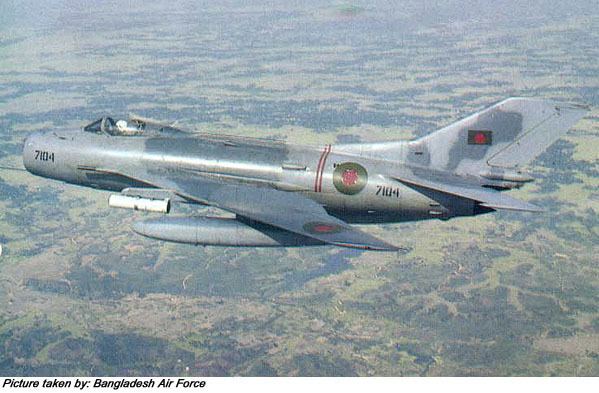Top speed 1,455 km/h Wingspan 9 m | Introduced March 1955 Length 13 m First flight September 18, 1953 | |
 | ||
Manufacturer Novosibirsk Aircraft Production Association | ||
Il2 mikoyan gurevich mig 19
The Mikoyan-Gurevich MiG-19 (Russian: Микоян и Гуревич МиГ-19) (NATO reporting name: "Farmer") is a Soviet second-generation, single-seat, twin jet-engined fighter aircraft. It was the first Soviet production aircraft capable of supersonic speeds in level flight. A comparable U.S. "Century Series" fighter was the North American F-100 Super Sabre, although the MiG-19 would primarily oppose the more modern McDonnell Douglas F-4 Phantom II and Republic F-105 Thunderchief over North Vietnam.
Contents
- Il2 mikoyan gurevich mig 19
- Design and development
- Operational history
- Vietnam War
- China
- Middle East
- Horn of Africa
- Nile Valley
- African Great Lakes
- Production aircraft designations
- OKB designations
- izdeliye designations
- Licence built versions
- Operators
- Specifications MiG 19S
- References

Design and development

On 20 April 1951, OKB-155 was given the order to develop the MiG-17 into a new fighter called "I-340", which was to be powered by two Mikulin AM-5 non-after-burning jet engines (a scaled-down version of the Mikulin AM-3) delivering 19.6 kN (4,400 lbf) of thrust. The I-340 was supposed to attain 1,160 km/h (630 kn; 720 mph) (Mach 1) at 2,000 m (6,600 ft), 1,090 km/h (590 kn; 680 mph) (Mach 0.97) at 10,000 m (33,000 ft), climb to 10,000 m (33,000 ft) in 2.9 minutes, and have a service ceiling of no less than 17,500 m (57,400 ft). The new fighter, internally designated "SM-1", was designed around the "SI-02" airframe (a MiG-17 prototype) modified to accept two engines in a side-by-side arrangement and was completed in March 1952.

The I-340 suffered from poor cockpit pressurization and the engines proved temperamental with frequent flameouts and surges with rapid throttle movements. The engines were upgraded to the AM-5A standard delivering 21.1 kN (4,700 lbf) of thrust each, which exceeded the power output of the Klimov VK-1F in afterburner while providing better fuel economy. The SM-1 was barely supersonic, reaching 1,193 km/h (644 kn; 741 mph) at 5,000 m (16,000 ft) (Mach 1.03). This performance was deemed insufficient for the new supersonic fighter and an after-burning version of the engine, the AM-5F, was proposed. While not implemented, the AM-5F served as the basis for the Tumansky RD-9 which powered production aircraft. Further development of the twin-engine concept resulted in a government request for the "I-360", internally designated "SM-2", powered by the AM-5F engines, but featured a highly swept wing.

The I-360 (SM-2), built in 1952, had 1.6 m (5.2 ft) longer fuselage, wingspan reduced to 9.04 m (29.7 ft), and weight increased to 6,802 kg (14,996 lb) and a new 55° sweep wing. The Nudelman N-37D cannon were moved to the wing roots to open space in a nose for the radar. Cockpit and landing gear were redesigned and a vertical stabilizer of increased area mounting a T-tail was fitted. In April 1952 the first prototype was sent to the Letno-Issledovatel'skiy Institut (en:flight research institute) (LII), flying for the first time on 27 May 1952 by G. A. Sedov. It was immediately clear that the AM-5A engines were not powerful enough, and they were replaced with AM-5F delivering 21.09–26.49 kN (4,740–5,960 lbf) (dry - wet), allowing a maximum speed of M=1.19 in horizontal flight. Flight testing prompted modifications to the air-brakes and control surfaces, re-designated as the SM-2A and after further modifications the prototype was re-designated again as the SM-2B.
The second prototype, SM-2/2 introduced horizontal stabilizers mounted on the upper rear fuselage and guns with shorter barrels. However the AM-5F engine was still not considered powerful enough, and both prototypes received yet more powerful 25.5–31.9 kN (5,700–7,200 lbf) (dry - wet) Mikulin AM-5B engines. Production versions of the AM-5 (Tumansky RD-9) were re-designated RD-9B and the SM-2B was re-designated SM-9/1 when these engines were fitted, effectively becoming the prototype of the MiG-19 series, flying for the first time on 5 January 1954, piloted by G. A. Sedov, making a total of 132 flights. Final changes included a modified air intake, new 23 mm (0.906 in) Nudelman-Rikhter NR-23 guns with 340 rpg, RSIU-3M "Klen" radio, "Uzel-1" transponder, and SRDM-1M "Konus" radio-rangefinder.
Initial enthusiasm for the aircraft was dampened by several problems, the most alarming inherited from MiG-15/MiG-17 was the danger of mid-air tank implosions when more than half of the fuel had been used - the leaking fuel of the crushed fuselage fuel tanks located between the engines would then ignite, leading to a fatal explosion; deployment of air-brakes at high speeds caused a high-g pitch-up; elevators lacked authority at supersonic speeds; high landing speed of 230 km/h (120 kn; 140 mph). Absence of a two-seat trainer version, slowed pilot transition to the type. Handling problems were addressed with the second prototype, SM-9/2, which added a third ventral air-brake and introduced all-moving tail-planes with a damper to prevent pilot-induced oscillations (PIO) at subsonic speeds, flying for the first time on 16 September 1954, entering initial production as the MiG-19.
The Soviet of The Ministers of the Soviet Union issued an order #286-133 to start serial production on 17 February 1954 at factories in Gorkiy and Novosibirsk. Factory trials were completed on 12 September 1954, and government trials started on 30 September. Problems with the initial production MiG-19, were addressed in the SM-9/3 prototype which pre-saged the MiG-19S production version, which supplanted the initial MiG-19 in production at Gorkiy and Novosibirsk from June 1956.
Approximately 5,500 MiG-19s of all versions were produced, in the USSR, Czechoslovakia as the Avia S-105 and People's Republic of China as the Shenyang J-6. The aircraft saw service with a number of other national air forces, including those of Cuba, North Vietnam, Egypt, Pakistan, and North Korea. The aircraft saw combat during the Vietnam War, the 1967 Six Day War, and the 1971 Bangladesh War.
All Soviet-built MiG-19 variants were single-seaters only, although the Chinese developed the Shenyang JJ-6 trainer version of the Shenyang J-6. With stabilization problems and "numerous crashes", the Russians had lost faith in the MiG-19, and moved on to the newly emerging MiG-21.
The J-6 remained a staple of the Chinese People's Liberation Army Air Force until the 1980s and has also been developed into the Nanchang Q-5 (NATO reporting name "Fantan") attack aircraft. Despite its age, the MiG-19 and its descendants exhibit good handling characteristics at low altitude and a surprisingly high rate of climb, and their heavy cannon armament, (a one-second burst from three 30 mm (1.181 in) Nudelman-Rikhter NR-30 cannon had a total projectile mass of 18 kg (40 lb) making the MiG-19 a formidable adversary in close combat.
Russian built MiG-19s were still in service in North Korea and Zambia as of 2014.
Operational history
During their service with Soviet Anti-Air Defense and in East Germany, MiG-19s were involved in multiple interceptions of Western reconnaissance aircraft. The first documented encounter with a Lockheed U-2 took place in the autumn of 1957. The MiG-19 pilot reported seeing the aircraft, but could not make up the 2,234 m (7,000 ft) difference in altitude. When Francis Gary Powers's U-2 was shot down in the 1960 incident, one pursuing MiG-19P was also hit by the salvo of S-75 Dvina (NATO: SA-2 "Guideline") missiles, killing the pilot Sergei Safronov. In a highly controversial incident, on 1 July 1960, a MiG-19 shot down an RB-47H (S/N 53-4281) reconnaissance aircraft in international airspace over the Arctic Circle with four of the crew killed and two captured by the Soviets (they were released in 1961). In another incident, on 28 January 1964, a MiG-19 shot down a T-39 Sabreliner which had strayed into East German airspace while on a training mission; all three crewmembers were killed.
Vietnam War
Hanoi decided in early 1969 to strengthen its air defenses by creating a third jet fighter unit; the 925th Fighter Regiment. This unit would consist of late model MiG-17s and the newly acquired MiG-19s (nearly all of which were J-6s from the People's Republic of China (PRC)). The regiment was established at Yen Bai, and by April 1969, nine combat-rated MiG-19 pilots were posted for combat duty. While some of North Vietnam's MiG-17s and all of their MiG-21s were supplied by the Soviet Union, the MiG-19s (J-6 models) were supplied by the PRC, which seldom exceeded 54 MiG-19s in number.
The first use and loss of a U.S. fighter to a MiG-19 (J-6) was in 1965 when a USAF Lockheed F-104 Starfighter piloted by Captain Philip E. Smith was attacked by a People's Liberation Army Air Force aircraft over Hainan Island. His Starfighter took cannon fire which damaged a portion of his wing and missile mount. Smith gave chase and did receive missile tone on the MiG but, within a millisecond of pressing his missile firing button, his Starfighter lost all power. He ejected and was captured. Smith was held prisoner until released on 15 March 1973, due to improving US-China relations following U.S. President Richard Nixon's visit to China in 1972.
The North Vietnamese Air Force began receiving the MiG-19 at the end of Operation Rolling Thunder, which ended in 1968. Despite their limited numbers, MiG-19s were involved in extensive combat during Operations Linebacker 1 and Linebacker 2 (a.k.a. the Christmas Bombing). The NVAF claimed only seven victories over U.S. aircraft, using the MiG-19, all of which were F-4 Phantom IIs. The MiG-19 was tested by U.S. pilots in the United States in 1969 after receiving a Chinese J-6 (F-6 exported model) from Pakistan. In addition to finding the aircraft to have a good canopy allowing good visibility for the pilot, along with 3 hard hitting 30mm cannons, U.S. pilots found the MiG-19 (J6/F6) to be an excellent fighter, "like the MiG-17, it could easily out-turn the Phantom...and could out-accelerate the F-4 out to Mach 1.2, but was slower than the MiG-21.". However, the MiG-19's strongest fault was its extremely short range, as one U.S. test pilot remarked, "after going in full after-burner at low altitude for 5 minutes, the MiG driver will be looking for a place to land!" This, combined with the aircraft's twin engines, which were difficult to maintain, made the MiG-19 unpopular with North Vietnamese pilots.
North Vietnamese Air Force (NVAF) and Communist Chinese air-space violation air-to-air kills; all 6 with 30mm cannon.
The MiG-19 lacked mounts for air-to-air missiles but it had the one advantage over the early model F-4 Phantom II: it was armed with a cannon. NVAF MiG-19s had three 30mm cannons which "were notable for their large muzzle flash" when fired. The aircraft were loaded with 90 rounds per cannon, giving approximately 6 seconds of firing time. A single 2 second burst of 90 shells could impact a U.S. aircraft with 81 lb (37 kg) of metal. This contrasted to a U.S. 20mm cannon such as the Vulcan which would deliver 39 pounds of metal.
Confirmed aerial victories by MiG-19s while assigned to the 925th FR, which match U.S. records occurred on: 10 May 1972 in which two F-4 Phantoms were shot down by MiG-19s flown by Pham Hung Son and Nguyen Manh Tung. Both NVAF victories over the F-4s were accomplished by cannon fire. Combat results of the 925th FR using MiG-19s, according to the North Vietnamese Air Force were: two F-4s on 8 May 1972; two F-4s on 10 May 1972; one F-4 on 18 May 1972; and two F-4s shot down on 23 May 1972; these losses were in exchange for 10 MiG-19s lost in aerial combat with U.S. jets. On 2 June 1972, in the skies over North Vietnam, a MiG-19 was the first recorded jet fighter to be shot down in aerial combat by cannon fire at supersonic speeds, by a USAF F-4 Phantom flown by Phil Handley.
China
The MiG-19 was in front line service with the PLAAF, and saw limited combat against the Nationalist opponent, the Republic of China Air Force (Nationalist China). One major air battle between Communist and Nationalist Chinese aircraft occurred in 1967, with 12 J-6s taking on four Lockheed F-104 Starfighters. Each side claimed one kill.
Reports surfaced of People's Republic of China J-6s (MiG-19s) flying combat missions during infrequent border squabbles with the Soviets, though with no records of dogfights, and encounters during the Vietnam War with U.S. aircraft that strayed into Chinese airspace. These confrontations resulted in a few losses of U.S. aircraft, with no recorded losses of Chinese aircraft, although the MiGs made hasty retreats back into the safety of Chinese airspace before the Americans could respond with reinforcements.
Middle East
In 1962, Egyptian MiG-19s saw some action in the ground-attack role during the civil war in Yemen during the early 1960s. The first reported air combat in the Mideast with the MiG-19 was on 29 November 1966, when two Egyptian MiG-19 fighters battled Israeli Mirage IIICs. The Israelis claimed two kills and no losses. Around 80 MiG-19s were in service with Egypt during the Six-Day War in 1967, but more than half were destroyed on the ground during the opening Israeli airstrikes of Operation Focus. Israeli pilots, however, did find the MiG-19 a potentially dangerous adversary because of its performance, maneuverability, and heavy armament.
Following the war, the Egyptians organized the surviving MiG-19 aircraft and assigned them air defense tasks of Egypt's interior. The Soviet Union did not supply Egypt with any replacement of the MiG-19s destroyed in the Six Day War, but Egypt might have received some from Syria and Iraq, so that by the end of 1968 there were 80+ MiG-19s in service with the Egyptian Air Force (EAF). The aircraft also saw combat during the War of Attrition; in one engagement on 19 May 1969, a MiG-19 aircraft engaged two Israeli Mirages, shooting down one with cannon fire while the other escaped. Egypt had around 60 Mig-19s in service during the Yom Kippur War of 1973 in which they served as close air support aircraft.
The Iraqis obtained some MiG-19S fighters in the early 1960s, but later sold them all off (a couple remaining in local museums), though the survivors did see some action against the Kurds in the 1960s. It is claimed that the Iranians acquired a batch of their own F-6s.
Horn of Africa
In the Horn of Africa, the Somali Armed Forces flew the F-6 against the Ethiopian National Defense Force during the Ogaden campaign. The SAF also used the aircraft against rebel positions in the late 1980s.
Nile Valley
In the Nile Valley, Sudan used its MiG-19S fighters against separatists in southern Sudan. At least one such aircraft was shot down.
African Great Lakes
In the African Great Lakes region, Tanzania flew MiG-19S fighters against Uganda during the war between the two states in 1978 and 1979.
Production aircraft designations
Data from::
OKB designations
izdeliye designations
Licence built versions
Operators
Specifications (MiG-19S)
Data from
General characteristics
Performance
Armament
Avionics
SRD-3 Grad gun ranging radar, ASP-5N computing gun-sight and an RSIU-4 Doob UHF radio
